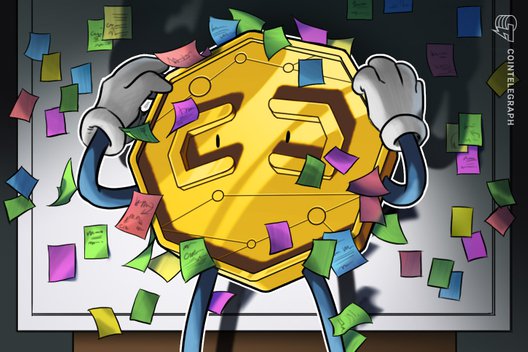It’s time to mature: We need compliant decentralized finance
The crypto space is an incredible, albeit risky, learning environment. Its volatility serves as a dire warning to those who like to test how deep the pool is by jumping in headfirst. Old guards constantly warn newcomers: “Take it slow, learn the basics and stack sats.” Wealth, in this space, can appear and disappear in an instant.
In 2018, many newcomers got their first taste of what a crypto winter feels like. This wasn’t the first time Bitcoin (BTC) crashed, and it won’t be the last.
Despite being around for more than 10 years, the crypto space is still in its infancy; the technology advances so quickly that every year we get to experiment with new concepts, new ideas, new applications and new ways to change the face of the world.
Related: Financial literacy will make the digital asset industry sustainable for the future
We also run into challenges as bad actors find new ways to scam people out of their hard-earned money, and with new untested projects that capture value but are highly vulnerable to failures, bugs and exploits. Decentralized finance falls within these new experiments; it holds the promise of exciting new ways of doing finance and investments, often with disastrous consequences.
Related: The chance for DeFi to fulfill the technology’s promise
As more and more traditional organizations take to crypto — like Square and PayPal — the opportunity to rise to the challenge is ours; it’s up to those who know the space, who understand its core values and want to see it become much more than a well-kept secret. This is a call to action.
Related: Will PayPal’s crypto integration bring crypto to the masses? Experts answer
What would a compliant DeFi look like?
Let’s start with defining “compliance.” It doesn’t just mean that the project follows Anti-Money Laundering regulations but also that it is up to quality and trust standards. This means that DeFi projects should step up in terms of security, quality, user responsiveness and regulatory compliance. Simply put, DeFi projects should guarantee resilience.
Let me be clear: This is not an argument for allocating blame and liability for losses — these are, after all, decentralized projects, not financial institutions — but there are billions of dollars stacked on DeFi projects, and this should account for something.
Related: Institutionalize crypto markets now: There must be compliance controls
Our goal should be to increase the number of users — i.e., encourage mass adoption — and attract traditional markets and nontechnical investors. We should aim at bringing blockchain and the benefits of DeFi to society. In times where governments are floating bonds with negative interest rates and turning on the money-printing machine, people need better solutions to keep their wealth. Better yet, people should be able to grow financially, regardless of the central bank that governs a specific currency or determines monetary policy.
Related: Corporate disclosure is the only way to get crypto institutionalized
So, what measures could DeFi projects, and the overall space, adopt to become more competitive and attractive to a wider client base? Let’s start with the basics:
Whitelisted addresses. A list of items/IP addresses that once they receive an initial validation are granted access to a certain system or protocol. In the case of DeFi, we could have one or two trusted anchors that could validate an address and conduct Know Your Customer diligence on the user. Once the user has been validated, all other projects within the same trust channel — i.e., a group of virtual asset service providers, or VASPs, that have agreed to follow the same set of rules and to collaborate within a well-delineated platform — can give that user access to products and services without having to redo the entire KYC process.
The advantage here is twofold: The user only shows private documents to one or two entities, thus reducing the surface area of attack for any potential data hacks, and the VASPs can have access to a larger user pool without having to increase compliance costs. A system like this could also enable individuals and entities who are excluded from traditional banking, savings and trading ecosystems due to geopolitical reasons to invest in yield-bearing products, alternatives to lending and high-interest accounts. DeFi is an alternative for these citizens and business owners to save, earn and transact.
AML- and GDPR-compliant systems. Institutional capital markets are strictly regulated and supervised by local and international regulatory bodies; the goal is to prevent money laundering and the financing of terrorist operations. With an attestation framework, projects can verify and comply with existing AML regulatory requirements and attract institutional capital while protecting users’ privacy by not requiring them to create copies of their personally identifiable information.
Related: GDPR and blockchain: Is the new EU data protection regulation a threat or an incentive?
Audited codebases and third-party certifications. There are plenty of blockchain projects out there that are not built under minimum acceptable standards, and it’s difficult for every user to go through the codebase and verify that the code is doing what it is meant to do. By having third-party validators go through the code — attesting to its integrity, functionality and reliability — the bar would be raised, making these projects more competitive and safer for investors.
Insurance. This is a relatively new area in blockchain, but there are projects that are tackling risk management through decentralized insurance. Insured projects can capture a wider audience that is willing to take on more market risk and less security risk.
Limits and safety margins. By building guardrails and layered security measures, users are given the option of increasing, or decreasing, their risk tolerance threshold. It also allows projects to limit their losses should a negative event impact them — for example, investment and withdrawal limits.
The right to choose is the right way
I strongly believe that individuals should be free to choose whether to risk their wealth on untested projects, on volatile investments and on bleeding-edge technologies; we shouldn’t have to rely on governments to tell us where, how much and when to invest. It’s ridiculous that an individual can spend thousands of dollars on lottery tickets but is not allowed to invest the same amount of money in venture capital projects without having to jump massive regulatory or bureaucratic hurdles.
This is why optionality becomes so important: It allows project builders to do what they do best and users to become the key driver in project evolution. The less credible a project is — especially in comparison with, for example, compliant, audited projects — the less capital and user base will flow toward it. These are market forces that should be allowed to move freely.
It’s important to also be clear that competition, in our space, is done on various levels; some require collaboration, some don’t. The overall objective is not to build the project that wins the short-term war but to build an industry that changes the lives of everyone, for the better, along with the way we do finance and wealth management — the way these are accessed by everyone, without unnecessary third parties or unbridled knee-jerk regulation. This is an infinite game.
The views, thoughts and opinions expressed here are the author’s alone and do not necessarily reflect or represent the views and opinions of Cointelegraph.
Juan Aja Aguinaco is an entrepreneur, startup consultant and co-founder of Shyft Network Inc. Previously, Juan was the chief operating officer of Decentral, one of Canada’s most influential blockchain innovation hubs. Before moving to Canada, he served as vice president and legal counsel for an oil and gas company based in Mexico City. Juan holds a Bachelor of Laws from Universidad Iberoamericana and an MBA from the Schulich School of Business.








